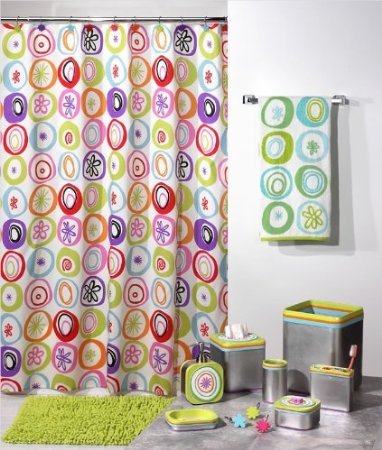The biggest challenge in remodeling a bathroom is probably working out how to achieve the style and build in the features you want within the limits of what is probably the smallest room in your house. A second limiting factor is the location of existing plumbing pipes and electrical wiring. You need to bear this in mind when considering bathroom redesign.
Remodeling a bathroom is relatively easy if you don’t have to move those. If you make radical changes in the existing layout, you’ll need to investigate whether or not you can build what you want without making structural changes.
Bear in mind that you might require a building permit, depending on the scope of your project. If so, you are probably going to have to submit a detailed plan of your proposed project.
Before you begin planning your new bathroom, check with your local building department and find out what codes, specifications and requirements you will have to meet.
Table of Contents
What to Think About First with Bathroom Redesign
There are a number of general issues you should consider before you begin designing your new bathroom. They include the layout. Consider your existing bathroom – which are the most serious problems you want to fix? If more than one person uses the bathroom at the same time, for example, is there enough counter space, or do you need a second sink or a shower compartment for greater privacy?
Are towel racks and tissue holders located conveniently? Do vanity doors or drawers interfere with opening and closing the bathroom door? Is there enough storage space for everyone who uses the bathroom?
The Mechanics
Now think about the mechanical systems. From the plumber’s point of view, the best bathroom layout is one that has all the rough plumbing–water supply and drain-waste-vent pipes–all in one wall. A “wet wall” as it is called not only saves materials, but makes it a lot easier to make repairs if needed.
Electrical outlets and switches are usually easier to move than plumbing pipes, provided there is reasonably easy access to the wiring. Likewise with heating ducts. If you can get to the duct, it is usually fairly straightforward to relocate the vent. Keep in mind though that any mechanical changes you make will cost more.
If your current layout is livable, leaving the mechanical systems as they are will mean that much more in the budget for upgraded fixtures, and may make the difference between doing the project and waiting to save more money before getting involved in bathroom redesign.
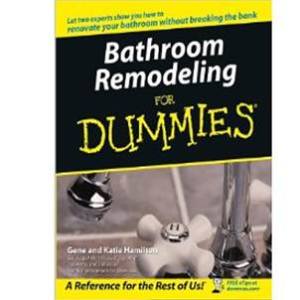
If you plan to install a two-person whirlpool then indirect mood lighting may fit well. With incandescent lighting, you are going to need at least 3½ – 4 watts per square foot (ie: 280 watts minimum in an 80-square-foot bathroom). If you use fluorescent lighting, figure on 1½ – 2 watts per square foot.
Bathroom Remodeling Book, on Amazon
Next you should think about the maintenance problems you have in your existing bathroom–stained grout, mildew or soap buildup. This is an important bathroom redesign factor to bear in mind. Some materials look great at the start when they are new, but do not last long in a high-moisture room. As you choose materials, make sure they are waterproof and washable–resilient vinyl flooring, for example, a fiberglass tub surround and semi-gloss enamel paint will all last.
Energy and water conservation. Your hot water heater is one of the largest energy hogs in the house, and the toilet uses more water than any other single fixture. Consider installing low-flow shower heads and insulating hot water pipes. The extra money you spend on an ultra-low-flush toilet will often come back in the first year in reduced water bills.
Make a Bathroom Redesign Sketch on Paper
The first step in planning your new design is to make a detailed sketch of your existing design. Use a sheet of graph paper with four squares per inch, and draw a floor plan (in other words, a bird’s eye view) to scale. Make each square represent 3 inches (so 1 inch represents 1 foot).
Fill in:
- all wall detail, plus the locations of any doors and windows
- the width and length of your floor cabinets and bathtub
- the locations of all electrical outlets, switches and fixtures
- the distance from the nearest wall to the center of the toilet and the centers of all sink drains
As you make your sketch, use an architect’s scale to precisely locate any components that do not fall on exact 3 inch increments.
Once you have a general idea of the style you want to incorporate into your new bathroom, the next step is to decide on the fixtures. The first place is to start is the bathtub. A standard builder’s bathtub is 30″ wide, 60″ long and typically about 15″ deep. But you can go up from there, to soaking tubs 36″ deep, square or sunken tubs, whirlpools or even free-standing claw-foot tubs if you like.
Tub surrounds range from one-piece folding fiberglass units to five-piece assemblies, and doors may swing, slide or fold.
The simplest sinks are wall-hung and these are also the cheapest type. Vanity sinks can be deck-mounted (set into a hole cut in the countertop) or part of an integral bowl and countertop (typically a cultured marble top).
There are three types of deck-mounted sinks. Self-rimming sinks have a molded lip that rests on the countertop, around the edge of the hole. They are the easiest to install, and there are a wide variety of styles available.
Flush or frame-rimmed sinks have a metal frame that is attached to the rim of the hole in the countertop. The sink is then fastened to the frame. This is an older style, typically used with laminate countertops.
Un-rimmed sinks are recessed below the surface of the countertop and held in place with metal clips. They are often used with ceramic tile or synthetic marble countertops.
You may or may not have room for a small storage closet in the bathroom; if so, it can be used for towels and other accessories. Your vanity cabinets will provide the bulk of the storage, however, so it’s important to choose them carefully.
Small Bathroom Redesign Ideas And Pictures
There are three basic types of base cabinets. A modular (as opposed to custom-built) sink base is typically 24″ to 36″ wide, with false drawer fronts and doors below. A drawer base can range from 12″ wide to 18″ wide – it generally makes the most of the space, with three or four drawers. A standard vanity base has one drawer, with a door below, and also comes in 12″ to 18″ widths.
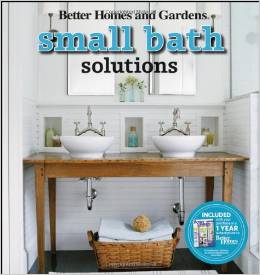
The most common type of toilet is a two-piece unit–a bowl and a tank. One-piece toilets are also available, in both a standard configuration and a low-profile model. What differentiates toilets (aside from color and style) is the flush design. The most common design is called a reverse trap. A siphon jet design is more efficient–and, of course, more expensive.
Small Bath Solutions Book, on Amazon
Once you have a rough idea of what fixtures you want, go to your supplier and measure them to get their outside dimensions. When you begin sketching out your new bathroom, cut out cardboard templates of each fixture to the same scale as your sketch. Lay the templates over the sketch of your existing bathroom and trace the walls and the locations of any components you know you will not move. Then begin planning your changes.
Minimum clearances vary by local building codes, so you’ll need to check with the building department before you design. There are four common types of bathroom layouts:
Bathroom Redesign Layouts
A one-wall bathroom has the tub, sinks and toilet all along one wall. This layout is generally the most economical–and generally the least interesting design.
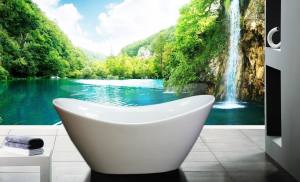
A corridor bathroom typically has the bathtub along one side wall and the vanity/sink and toilet along the opposite wall.
European Style Bathtub, on Amazon
A U-shaped bathroom has fixtures on three walls; it generally gives the most spacious appearance, but also needs a large, square room to begin with.
Start with the Tub Position
Begin your layout by positioning the bathtub. Make sure you have easy access, room to maneuver if you’ll be bathing small children and nearby wall space for a towel rack. The bathtub is often placed against the back wall to keep it away from the bathroom door.
Next, locate the sink and vanity cabinet. Plan for at least 30″ clear space in front of the sink, so there is room to bend down and get into the cabinet. If the sink is placed along a side wall near the door, make sure the door swings away from the sink–not into it.
Then locate the toilet, away from the door if possible. Most building codes require at least 20″ clearance in front of the bowl. On each side, you’ll probably need 18″ to the nearest wall or 14″ to the nearest cabinet (measured from the center of the bowl).
Bathroom Storage
If you have space for extra storage, naturally you’ll want to use it; the most important consideration in designing storage space is putting everything you need within easy reach. You’ll certainly need some shelf space, but you can also make efficient use of space with wire racks, bins and drawers. If you use modular units, you’ll be able to adjust your storage space later for changing needs.
Draw up a general outline of construction procedures, then list the materials that will be needed for each phase. Talk to your supplier(s) and find out the lead times on any special order materials.
Place special orders in advance so they will be available when you need them; allow enough extra time beyond the planned order time, so mistakes can be corrected without holding up the job. Arrange for a building inspector to check the job whenever necessary.
Bathroom Redesign Decorating
Bathroom decorating is one of the tasks throughout your home that many people enjoy doing, and even the smallest of improvements can make all of the difference. There are vast arrays of different ideas, which can make the bathroom more appealing. You will be amazed at how little you have to spend to make a difference.
What to Think About
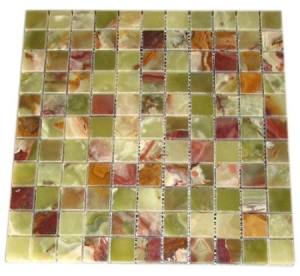
These include your existing bathroom decor, how large the room is, and what your overall budget is for the decoration task. Once you have decided what style and color to have your bathroom, you need to decide if you are remodeling completely, or simply freshening the room.
Mosaic Green Onyx Bathroom Tile, on Amazon
If your budget is larger, you may be considering buying a whole new bathroom suite, and changing the layout of the room.
This can make a huge difference to the flow throughout the bathroom, and increase the value of your home. However, you need to consider family life before you rip out your existing bathroom and begin work.
Living without a bathroom, even for a short space of time can be stressful, and is often why people decide to complete smaller bathroom decorating plans. You will be amazed at how much better your bathroom looked with a fresh coat of paint, and new accessories. There are many different styles of accessories to choose, which fit your taste and budget.
Bathroom Flooring
Flooring is another part of your bathroom décor and bathroom redesign, which can make all of the difference, and you will be surprised how much cleaner and brighter it will be with the right flooring. You need to ensure that you choose flooring, which is waterproof and can be cleaned easily. Light colours can make a small bathroom look far bigger, and more inviting for everyone.
What to Do with the Walls
Walls should be either tiled or painted with light colors, to ensure that they look fresh and clean. Pastels are very popular in bathrooms, and there are several different shades to choose. Bright or dark colors can be depressing, and make your bathroom feel far smaller. You need to find a good balance between inviting and calming, which is how you should feel in the bathroom.
Bathroom Storage
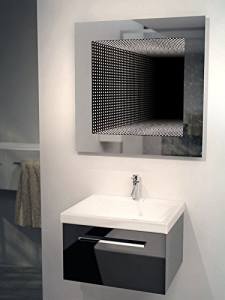
Clutter is never attractive; however, in bathrooms it can also be dangerous as water can produce slippery floors.
Using Glass and Mirrors in Bathroom Redesign
Glass and mirrors are an excellent addition to all bathrooms, and smaller ones will benefit greatly from these two decorating ideas. Shower curtains are incredibly dated, however, glass doors, panels or bricks are modern, bright, and make your bathroom look fantastic.
You will ensure that light is projected throughout the space, and give the illusion of a larger space.
LED Infinity Mirror, on Amazon
Bathroom Decoration
Regardless of your budget, there are many different decorating ideas, which can make your bathroom feel brighter, cleaner, and completely modern.
You need to ensure that you remodel your bathroom how you would like it to be, however, considering the style of your house is essential. If you have a period house, an ultra-modern bathroom might be a bit odd, so you might want to match your bathroom style to the rest of the house, so it all ties together better.
